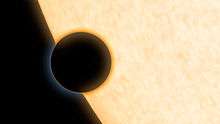HAT-P-11
| Observation data Epoch 2000 Equinox 2000 | |
|---|---|
| Constellation | Cygnus[1] |
| Right ascension | 19h 50m 50.25s[2] |
| Declination | +48° 04′ 51.1″[2] |
| Apparent magnitude (V) | 9.473[3] 9.59 [4] |
| Characteristics | |
| Spectral type | K4 [4] |
| Apparent magnitude (B) | 10.66±0.05[3] |
| Apparent magnitude (J) | 7.608±0.029[5] |
| Apparent magnitude (H) | 7.131±0.021[5] |
| Apparent magnitude (K) | 7.009±0.020[5] |
| Astrometry | |
| Proper motion (μ) | RA: 127.20±0.83[2] mas/yr Dec.: 231.23±0.80[2] mas/yr |
| Parallax (π) | 26.69 ± 0.85[2] mas |
| Distance | 122 ± 4 ly (37 ± 1 pc) |
| Absolute magnitude (MV) | 6.57±0.09[4] |
| Details | |
| Mass | 0.81+0.03 −0.02[4] M☉ |
| Radius | 0.683±0.009[6] R☉ |
| Luminosity | 0.26±0.02[4] L☉ |
| Surface gravity (log g) | 4.59±0.03[4] cgs |
| Temperature | 4780±50[4] K |
| Metallicity [Fe/H] | 0.31±0.05[4] dex |
| Rotational velocity (v sin i) | 1.5±1.5[4] km/s |
| Age | 6.5+5.9 −4.1[4] Gyr |
| Other designations | |
HAT-P-11, also designated GSC 03561-02092, is an orange dwarf metal rich star about 123 light-years away in the constellation Cygnus. This star is notable for its relatively large rate of proper motion. The magnitude of this star is about 9, which means it is not visible to the naked eye but can be seen with a medium-sized amateur telescope on a clear dark night. The age of this star is about 6.5 billion years.[3]
The star has active latitudes that generate starspots.[7]
Planetary system
An extrasolar planet, was discovered by transit method of the HATNet Project, believed to be a little larger than Neptune.
That planet orbits out of alignment from the star's spin axis. The system is oblique at 100°.[7]
This star system was within the field of view of the Kepler Mission planet-hunter spacecraft.[4]
| Companion (in order from star) |
Mass | Semimajor axis (AU) |
Orbital period (days) |
Eccentricity | Inclination | Radius |
|---|---|---|---|---|---|---|
| b | 0.081±0.009 MJ | 0.053+0.0002 −0.0008 |
4.8878018±0.0000016 | 0.198±0.046 | — | 4.58±0.15 R⊕ |
See also
References
- ↑ Roman, Nancy G. (1987). "Identification of a Constellation From a Position". Publications of the Astronomical Society of the Pacific. 99 (617): 695–699. Bibcode:1987PASP...99..695R. doi:10.1086/132034. Vizier query form
- 1 2 3 4 5 van Leeuwen, F. (2007). "Validation of the new Hipparcos reduction". Astronomy and Astrophysics. 474 (2): 653–664. arXiv:0708.1752
 . Bibcode:2007A&A...474..653V. doi:10.1051/0004-6361:20078357. Vizier catalog entry
. Bibcode:2007A&A...474..653V. doi:10.1051/0004-6361:20078357. Vizier catalog entry - 1 2 3 4 "SIMBAD query result: G 208-41 -- High proper-motion Star". Centre de Données astronomiques de Strasbourg. Retrieved 2009-04-22.
- 1 2 3 4 5 6 7 8 9 10 11 12 Bakos, G. Á.; et al. (2010). "HAT-P-11b: A Super-Neptune Planet Transiting a Bright K Star in the Kepler Field". The Astrophysical Journal. 710 (2): 1724–1745. arXiv:0901.0282
 . Bibcode:2010ApJ...710.1724B. doi:10.1088/0004-637X/710/2/1724.
. Bibcode:2010ApJ...710.1724B. doi:10.1088/0004-637X/710/2/1724. - 1 2 3 Skrutskie, M. F.; et al. (2006). "The Two Micron All Sky Survey (2MASS)". The Astronomical Journal. 131 (2): 1163–1183. Bibcode:2006AJ....131.1163S. doi:10.1086/498708.Vizier catalog entry
- 1 2 Deming, Drake; et al. (2011). "Kepler and Ground-based Transits of the Exo-Neptune HAT-P-11b". The Astrophysical Journal. 740 (1). 33. arXiv:1107.2977
 . Bibcode:2011ApJ...740...33D. doi:10.1088/0004-637X/740/1/33.
. Bibcode:2011ApJ...740...33D. doi:10.1088/0004-637X/740/1/33. - 1 2 Roberto Sanchis-Ojeda; Josh N. Winn; Daniel C. Fabrycky (2012). "Starspots and spin-orbit alignment for Kepler cool host stars". Astronomische Nachrichten. 334: 180–183. arXiv:1211.2002
 . Bibcode:2013AN....334..180S. doi:10.1002/asna.201211765.
. Bibcode:2013AN....334..180S. doi:10.1002/asna.201211765. - ↑ "Clear skies on exo-Neptune". www.spacetelescope.org. ESA/Hubble. Retrieved 25 September 2014.
External links
- "HAT-P-11". Exoplanets.
Coordinates: ![]() 19h 50m 50.2469s, +48° 04′ 51.085″
19h 50m 50.2469s, +48° 04′ 51.085″
